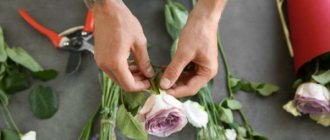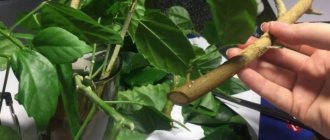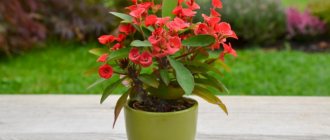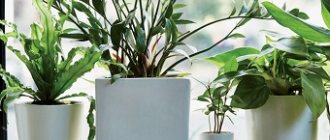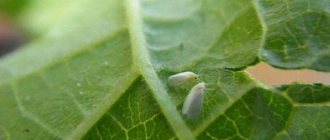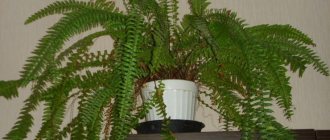There are several ways to propagate plants - using seeds or vegetatively. Seed propagation has a number of advantages. But in order to preserve all the characteristics of the original plant, vegetative propagation is mainly used. Methods of vegetative propagation include leaf and stem cuttings, grafting, layering, propagation methods using cell culture, etc. Some plants at home are difficult to take cuttings or there is no way to get cuttings, others cannot be propagated at all by vegetative methods, then you have to resort to seed propagation. But the most common way to propagate plants at home is cuttings.
Rooting cuttings
There is a small group of plants that can produce a new plant from part of a leaf, such as Sansevieria. Others require at least part of the petiole in addition to leaf plastic to recreate a new plant. These are begonia rex, zamioculcas, uzambar violet, aloe, kalanchoe, crassula, etc.
Other plants are able to recreate themselves only from a part of the stem that bears one or more buds. In this way, you can propagate ficus, hibiscus, abutilons, citrus fruits, myrtles, and many other plants. For many years I have been successfully making cuttings of various trees, shrubs and vines, which I grow as indoor plants. I want to share my practical experience.
Cutting time, cutting selection
The best time for cuttings for the vast majority of plants is spring-autumn, the period of active growing season. However, cuttings are also possible at other times - plants, although with great difficulty, take cuttings. When, with the onset of autumn cold weather, you have to bring plants from the balcony into the room, there is absolutely not enough space on the window sills, and you have to heavily trim the plants that have grown over the summer. It’s a pity to throw away cut branches, so you have to put them for rooting.
The cutting must be taken from a healthy, stable plant. You cannot take cuttings from a plant that has suffered stress. Cuttings taken from recently purchased imported plants root poorly. The fact is that these plants, in order to quickly achieve a spectacular presentation, are stimulated with special substances to flower, fruit and grow, which inhibits their root formation process. From experience, only after a year does the plant begin to take cuttings with normal yield.
Cuttings should be semi-lignified, when the bark at the apical part of the cutting is still green, and at the cutting level has recently become lignified. It is better to take them from this year's fresh growth. Cuttings from plants that are overfed, especially with nitrogen, take root poorly—they often simply rot.
Most plants have waves of growth: first, young shoots grow actively, then they seem to freeze, then they begin to grow again. It is at the fading stage that it is advisable to take cuttings. For citrus fruits, it is recommended to take shoots for rooting that have already acquired a rounded shape from the ribbed ones. In many flowering plants, the shoot reaches the required stage for cuttings immediately after flowering (bougainvillea, plumbago, clerodendrum).
Usually the cutting contains 3-5 buds for large-leaved plants such as hibiscus, abutilon, ficus. For small-leaved plants, such as myrtle, the number of buds is greater, the cutting length is approximately 6-10 cm. The cuttings can be either apical, i.e. cut from the top of the shoot, and intermediate ones. So, a branch of bougainvillea or passionflower can be cut into pieces of 3-4 buds and get 5-10 cuttings at a time.
Cyperus
The thin-stemmed plant is a fairly bushy bush that likes slightly moist soil and air. It grows successfully in soil with an acidity pH of 5-6. In the spring, every 3 weeks it is worth feeding the crop with complex mineral supplements.
Replanting is rarely required, only as the plant grows. The method of reproduction depends on the species. Cuttings can be applied to many varieties, except Cyperus papyrus, which is grown from seeds or by dividing the bush. Cuttings are prepared in the spring, cut from a large bush and kept in water.
Soil and container for cuttings
Many plants grow roots well in water; you just need to put an activated carbon tablet in the water so that the water does not spoil. It is advisable that the container with water is not transparent (dark glass, opaque plastic). It is necessary to monitor the purity of the water and change it if necessary. This is how you can achieve root growth in monstera, syngonium, scindapsus, and epipremnum.
Other plants (ficus, myrtle, hibiscus) can also take root in water, but when cuttings are planted in the ground, the roots are replaced with new ones and the plants take a long time to get used to the new conditions. In addition, the rooting process in the ground is faster and less painless. Therefore, I prefer to root cuttings in an earthen substrate. Successfully, with almost 90% yield, not only ficus, hibiscus, but also myrtles, eugenias, metrosideros, callistemons, olives, plumbago, pomegranates and many others take root in it.
The soil must be taken depleted in organic matter - it is of no use, excess organic matter will only cause decay. My substrate consists of 50% peat and 50% sand with the addition of crushed sphagnum. Sphagnum is added to lighten the soil, to increase moisture capacity and bind the substrate, so that when transplanting a rooted cutting to a permanent place, the lump of earth does not collapse. It is important that the substrate is sterilized. At home, you can steam the mixture in the microwave. I steam it in a large saucepan, put sifted and washed sand on the bottom in a layer of several centimeters, put peat on it, and, if necessary, other substrate ingredients on top, steam a 10-liter saucepan on the stove for 40 minutes. Sterilization kills all pathogenic micro- and macroorganisms and kills weeds.
However, it is possible to disinfect the sustratum without steaming, using microbiological agents Siyanie or Vostok-EM1, using the technology for preparing the substrate for growing seedlings, described in the instructions for the preparations. This requires a time reserve of more than 2 weeks, during which microorganisms multiply and suppress the pathogenic microflora present in the soil.
After this, I mix sand, peat, add sphagnum, put it in transparent disposable cups, and first cut off part of the bottom and walls with scissors to obtain drainage holes. Transparent dishes allow you to monitor the process of root formation - the roots are clearly visible, there is no need to disturb the plant. I take 200 ml cups for large-leaved cuttings and 100 ml for small-leaved ones. After the finished substrate is laid out in cups, I lightly soak it. Do not allow the substrate to become too wet.
WHAT SHOULD BE DONE
Before you begin harvesting cuttings and rooting them, it is important to decide on the following issues:
- Find out what kind of houseplant it is, whether it can be propagated by cuttings and read tips on how to do this specifically for this species;
- Select and cut the cuttings correctly;
- Prepare dishes for rooting and soil suitable for this plant;
- Treat with a root growth stimulator, if necessary;
- Plant the cuttings and care for them properly.
Some indoor plants take root easily and quickly. There are no problems with the rooting of balsam, zonal pelargonium, tradescantia, and coleus. Large-flowered pelargoniums are more capricious. Ficuses and begonias are almost always successfully propagated by cuttings. Azaleas and gardenias are difficult to root. If you don’t have any experience, then it’s better to practice on the most unpretentious and easily rooted house flowers.
Preparation of cuttings
For a cut branch, you must immediately make an oblique cut under the lower bud and remove the leaf. If there is milky juice (from ficuses), be sure to hold it under running water until the juice is released. Dip the lower part of the cutting into Kornevin and immerse vertically in a glass with substrate up to the next leaf so that the second bud from the bottom is at the level of the substrate. We must try to ensure that the stalk sits tightly in the soil and does not dangle; to do this, I do not cut off the second leaf from the bottom, but slightly deepen its petiole into the substrate. The cutting must have at least one or two more buds, from which the future plant will develop. Rubber-bearing ficus, for example, can be propagated by a piece of stem with only one bud, but such a cutting will have less chance of producing a new plant than a longer one. In small-leaved cuttings, the number of buds inside the substrate and on top will be greater. Sometimes it is recommended to wound the stem of the cutting (in citrus fruits, hibiscus). This is done with a clean needle - the bark of that part of the cutting that will go underground is slightly scratched.
ROOT FORMATION STIMULANTS
Some gardeners, before planting cuttings, soak them in a solution of heteroauxin or other root formation stimulant. Such substances promote plant regeneration, stimulate root formation in cuttings, accelerate root formation in seedlings and adult plants, and enhance the growth of adventitious roots. There are different medications. The cuttings are either soaked in a solution, or sprinkled with powder, or watered under the root strictly according to the instructions.
These root formation stimulators make it possible to obtain new specimens from cuttings of even the most difficult plants to propagate.
Greenhouses and lighting
After planting, you need to spray the cuttings with water and Zircon and put them in a greenhouse. The greenhouse is a container covered with plastic film, into which cuttings are included with a margin of height. The greenhouse can be made from an old glass aquarium, maybe not completely airtight, a deep plastic basin or container. A mini-greenhouse can be built from a 5-liter or 1.5-liter water bottle, cutting it crosswise.
Rooting cuttings
The cuttings must be kept in conditions of high humidity until they form their own roots, which will take over the process of supplying the plant with water. But in addition to 100% humidity, cuttings need light to root. It is not recommended to place cuttings in the sun, since overheating inside the greenhouse is possible, so additional lighting is provided. Special phytolamps, especially LED ones, are best suited for illumination, but it is quite sufficient to use cheaper, albeit less economical, fluorescent lamps. By the way, among them there are energy-saving phytolamps, which, however, produce pink light that is not very pleasant to the eyes.
Rooting cuttings
Daylight hours should optimally last 12 hours. Observance of day and night is mandatory. The optimal temperature for rooting is +25 degrees; at lower temperatures, root formation is reluctant. For many plants (for example, bougainvillea), bottom heating is desirable when the substrate temperature is higher than the air temperature. On my shelving, this is achieved by heating from a fluorescent lamp, which illuminates the shelf below.
I expect the first results of rooting in 2 weeks for myrtle, melaleuca, callistemon, rosemary, abutilon, fig, ficus. After a month - for hibiscus, bougainvillea, metrosideros, eugenias, psidiums, citrus fruits, olives. I carefully take out the cups - the formed roots are clearly visible through the transparent walls of the cups.
Echeveria
A stemless plant with fleshy and short densely spaced leaves resembles a rosebud. The color of the leaves differs depending on the variety. They are green, pinkish, yellow. Echeveria reaches a height of 30 cm.
The plant is unpretentious in care. Needs timely watering, nutritious and light soil, moderate lighting. To plant the crop, you can mix humus, leaf soil, small pebbles and sand.
Echeveria is propagated by carefully cutting off the bottom leaf, drying it for 3 hours, and then placing it in a mixture of soil and sand (2:1). The soil is sprayed, the container is covered with a plastic cap. After 2-3 weeks, when shoots appear, the first leaf is removed.
How to adapt rooted cuttings to indoor conditions
Cuttings take root in a greenhouse at a humidity close to 100%. When they are abruptly transferred indoors after the formation of roots, partial wilting of the leaves is observed. To avoid this and give the cuttings the opportunity to acclimatize to environmental conditions, it is enough to spray some plants several times a day, others have to be placed in loosely closed greenhouses for several days, ventilated frequently, gradually accustoming them to dry air.
2 weeks after transplanting into pots, rooted cuttings can begin to be fed to support the active growth of young plants.
Photo by the author
TRANSPLANTING YOUNG PLANTS
The resulting seedlings need to be transplanted into separate pots. For many plants, this stage is considered the most difficult. Many species do not tolerate root damage. Others don't like changes in temperature or soil.
How to replant? The rule is simple - replant rooted cuttings only by handling, without shaking off the soil, trying not to damage the weak roots.
When to replant? The shoots rooted in the cups are replanted when it is clear that the roots have entwined the earth well. If the walls are not transparent, then replant if roots appear in the drainage hole. Cuttings in a common box are more difficult to separate from each other; they are usually replanted when they begin to grow and produce a new leaf. Being late in replanting from a separate cell or cup will not do much harm; it will only slow down the development of the plant a little, while in a box the roots may become so intertwined that it will be difficult to separate them.
How to adapt? A sudden change in conditions can destroy the plants obtained with such difficulty. If the seedling is moved to another place or into the open air, then before transplanting it must be accustomed to the new habitat. The shelter is removed from it, moved to another place, first for several hours, then the time is increased. Plants must get used to lower temperatures and different lighting.
Reproduction by mustache
You can propagate episcia, saxifraga, chlorophytum, and tolmia with mustaches.
At the ends of the shoots of such plants, small daughter plants (whiskers) appear. If they have roots, then the mustache is simply carefully separated and planted in a moistened soil mixture. Whiskers without roots need to be rooted in the same way as for cuttings.
How to get a new flower from leaves
There are three ways:
- whole leaf;
- a piece of leaf;
- whole leaf with petiole.
Leaf without division
Whole leaves are used for plants with thick, succulent leaves, like Rex begonia.
Propagation by whole begonia leaf
The veins of the prepared planting material are cut from below. Before propagation, planting material is dried. Coarse sand is poured into a container with good soil on top and spilled. The sheet should be placed on the bottom side and pressed a little.
A piece of leaf
This option is suitable for:
- Royal begonia;
- Mason Begonias;
- sansevierias;
- Streptocarpus.
The leaves are cut into pieces no larger than five centimeters. Planting is done using prepared soil. You can use compositions for indoor flowers, which are sold in specialized stores. The leaf plate should not come into contact with the soil; it should be supported by a support.
When favorable conditions are created (high humidity, warm air and watering), the root system forms quickly.
Whole leaf with petiole
A leaf with a petiole is a good material for obtaining:
- Saintpaulium;
- gloxinia;
- begonia.
The leaf should be taken from a healthy plant at the base. Use a sharp knife for cutting. The length of the petiole is usually 1 or 3-4 cm.
Propagation by leaf cuttings of Saintpaulia
You can get the root system in different ways:
- Place the leaf in a container of water. The petiole should be long, up to 4 cm.
- When rooting in the ground, the petiole is shortened to one centimeter. The cut is treated with a phytohormone solution. The leaf is placed directly into the hole with the bottom side facing the wall of the container. Planting material should not be allowed to come into contact with the ground.
Reproduction by division
You can propagate violet, arrowroot, asparagus, fern, sansevieria, and calathea.
When growing, these plants are able to form rosettes (small daughter bushes). In this regard, such a plant can be divided.
It is recommended to propagate by division in spring or June. The mother plant is removed from the ground, the soil is removed and the daughter part of the plant is carefully cut off or broken off. In this case, you need to cut where the daughter and mother flowers connect. The cutting should have a healthy growing point and developed roots. Plant in moist soil mixture. Before a young shoot appears and complete rooting occurs, the soil must be constantly moist. The plant also needs to be protected from direct sunlight.
Reproduction by offspring
Bulbs and bromeliads, as well as cacti, can be propagated by offspring.
The daughter plant developing from the base of the mother plant is an offspring. After such plants have developed well, they are separated from the mother plant using a sharp knife or by hand, while trying to make a cut closer to the main flower. We must try to ensure that the separated offspring has many roots of its own. The separated offspring is planted in an individual pot, and is given the same care as cuttings.
Small bulbs appear on the mother bulbous plant. They need to be carefully separated and placed in a separate container. They usually flower after 1 or 2 years.
Reproduction by children
You can propagate Degremona, Kalanchoe, Bryophyllum degremona, Kalanchoe tubiflora.
As a rule, children with their own roots develop at the tips of the leaf blades of these plants. They are separated with your fingers, and special care must be taken so as not to damage the delicate roots. They are planted in containers filled with wet soil mixture. When the flowers grow, they should be planted in separate pots.
Reproduction by layering
Climbing plants, as well as hanging plants with long shoots, such as ivy, chlorophytum and others, can be propagated by layering.
This type of propagation is different in that a young plant is formed without being separated from the mother plant.
After sprouts appear on fairly long shoots, they try to fix them with a wire or pin on the surface of a special soil mixture. Rooting occurs quite quickly. A young plant should be separated when its root system has formed and it begins to grow on its own.
Propagation by seeds
Several types of cacti, primrose, fuchsia, cyclamen, and coleus can be propagated by seeds.
Indoor plants are propagated by seeds extremely rarely, because this is a rather complicated method. However, if you wish, you can still try to grow a spectacular plant from a tiny grain. Also, thanks to this propagation method, it is quite possible to obtain a new form of plant (for example, with a different color). Beginners are recommended to choose annual plants for the first sowing, as they are relatively easy to grow.
In March–April, seeds of quickly germinating plants are sown, and in the last winter weeks - those that take a long time to germinate. If the seeds have a thick skin, they will require preliminary preparation; for example, they can be doused with freshly boiled water or placed in liquid for several days. You can also treat the seeds with aloe juice. This will speed up germination and also speed up the start of flowering.
Before sowing, the soil must be heated in the oven. An earth mixture consisting of sand and peat, taken in equal proportions, is suitable for this. You can add a small amount of vermiculite. A ready-made soil mixture intended for growing seedlings is also suitable for sowing.
Fill the pot or tray with soil, level its surface and compact it slightly. Distribute the seeds (not thickly) over the surface of the substrate and sprinkle them on top so that they peek out slightly. Water using a watering can with a strainer or a sprayer. Cover the top of the container with glass or film. Provide the seedlings with the necessary temperature conditions, as well as the required level of lighting (this information can be found on the packaging).
Caring for planted seeds is quite simple. They just need to arrange systematic ventilation, as well as provide regular watering using a sprayer. After the seedlings appear, the shelter is removed and the container is placed in a well-lit place.
Picking seedlings
In order for the plant to have strong roots, the seedlings must be pricked. As a rule, this procedure is carried out 1 to 3 times. There are flowers that do not need picking, but some, on the contrary, need to be picked 5 or even more times. The first picking is made after the formation of 1–2 true leaves. With each subsequent transplant, a substrate more saturated with nutrients is used.
To make a hole for the seedling, you can use a peg, pencil or pen. Insert it to the required depth and then pull it out. After this, the seedling can be planted; the soil mixture must be moist, and watering after planting must be done using a sprayer. In order for the seedlings to take root faster, they are sprayed with a solution containing phytohormones, and then covered with glass or film.
Cuttings are one of the most popular methods of propagating indoor plants. And this is not surprising, since this method, without damaging the mother plant, can produce large and rapidly growing offspring. And although there is nothing complicated in ordinary rooting under a hood, there are some indoor plants that will not cause even the slightest trouble. The most unpretentious crops require almost no effort to root cuttings: after all, roots appear on their shoots even in water.
Cuttings of indoor plants. © lenna pettersson
Cuttings are one of the main methods of propagation not only for garden plants, but also for indoor plants. Of course, among the vegetative methods there are also simpler procedures - in particular, the division of adult bushes. But it is cuttings that are most often used both on an industrial scale in crop production and at home.
The main advantage of cuttings is rightfully considered to be the minimal harm caused to the plant itself. Only a few shoots are cut into cuttings (with the exception of replacing mother bushes in annual species); this procedure does not cause serious injury to the plant and does not lead to inhibition of its growth. But there are other advantages:
- minimal harm is combined with maximum effectiveness;
- cuttings allow you to get a large number of new plants in a minimum period of time;
- plants obtained by cuttings develop faster and a minimum period of time passes to achieve their maximum decorative effect;
- Rooting cuttings allows you to replace old plants in need of rejuvenation or annual plants.
The plants that are easiest to take cuttings are some of the most popular. And this is not surprising. Choosing indoor crops that easily take root and reproduce allows you to study the characteristics of plant propagation, quickly restore neglected ones, and replace old and out-of-shape specimens even with minimal knowledge and experience.
The ease of cutting directly depends on what kind of cuttings can be taken from a houseplant. For reproduction you can use:
- apical cuttings;
- stem cuttings;
- leaf cuttings.
If you want to get new plants using cuttings without much effort, then first of all you should pay attention to crops that are propagated by apical cuttings. But even among the crops that can be cut from leaves or stem segments, there are those that take root with amazing ease.
Propagation of indoor plants by cuttings
Tip cuttings are an excellent propagation method for most indoor vines. You can easily get new plants by cutting off the tips of the shoots from cissus, epipremnum, ivy, hoya, solenostemon and tradescantia. It is also easy to root the tops of the shoots of peperomia, ficus benjamina, sytya, impatiens, African sparmania, etc.
Leaf cuttings even make it possible to obtain new plants from a single leaf or even part of it. This is the most productive way to propagate sansevieria, begonia, saintpaulia, streptocarpus, crassula, rubber ficus, and echeveria. Parts of leaves and stems also take root well in succulents or cacti.
Stem cuttings always seem to be a more difficult method of propagation, but not for plants that take root easily in any conditions. These include yuccas and dracaenas, which quickly produce roots even on pieces of the stem.
Let's take a closer look at ten indoor plants that are easiest to take cuttings. Cuttings taken from them take root amazingly quickly even in plain water, and the offspring develop so actively that after just a couple of months you will be able to admire the highly decorative plant.
For a list of indoor plants that are easy to obtain from cuttings, see the next page.
Read: 525
The best period for cuttings of many ornamental plants is from mid-June to early July.
The most common method of vegetative propagation of indoor plants is cuttings. Cuttings are the rooting of parts of a stem (stem cuttings) or a leaf (leaf cuttings).
Most indoor plants can only be propagated from stem cuttings, but begonias and gloxinias can grow even from part of a leaf.
by stem cuttings:
| Abelia (in green) | Callistemon | Rhododendron |
| Abutilone | Calceolaria (rare) | Poupsetia (apical) |
| Azistasia | Codeium | Rhombophyllum |
| Akka Zellova | Koleriya | Ruellia |
| Allamanda | Coleus | Portulacaria |
| Aloe | Campanula equifolia | Ivy |
| Anredera | Columneya (cuttings are taken from the upper parts of shoots cut after flowering) | Plectranthus (tops of shoots after flowering) |
| Ardisia | Cordilina | Pig |
| Asklepis | Coffee | Saintpaulia (apical) |
| Aucuba | Ragwort | Setcreazea |
| Balsam | Laurel | Sinningia |
| Begonia | Lemon | Sparmannia |
| Bryophyllum (easier to propagate by “children”) | Mesimbryanthemum | Stapelia - starflower |
| Browallia | Spurge | Stephanotis |
| Brunfelsia | Monstera | Scindapsus |
| bougainvillea | Murray | Tetrastigma |
| Gesneria | Nandina | Crassula |
| Hibiscus | Oleander | Tradescantia |
| Gimura | Oplysmenus | Thunbergia |
| Hydrangea | Oscularia | Fatsia (apical) |
| Hoffmania | Ottone | Fatshedera |
| Dieffenbachia | Ohna | Faucaria |
| Dichorysandra | sedum | Ficus |
| Dracaena (tops) | Pandanus | Philodendron |
| Dudleya | Passionflower | Fremontia |
| Duranta Plumier | Pachyphytum | Fuchsia |
| Evgeniya | Pelargonium (it is better to take semi-lignified cuttings that are green on top) | Conifers |
| Jasmine | Pepper | Hoya |
| Isoloma (apical only) | Pilea | Ceropegia |
| Irezina (apical and semi-lignified) | Pittosporum - resin seed | Cyperus |
| Kazura | Cissus | Jacobinia |
| cacti | Echeveria | |
| Kalanchoe (peduncles act as cuttings) | Viburnum (apical semi-lignified) |
Propagated by leaf cuttings and leaf parts:
| Aloe | Kalanchoe | Streptocarpus |
| Begonia | Sansevieria (leaves with stripes - only part of the leaf, otherwise the color is not transmitted to the daughter plants) | Ficus |
| Gavortia and Gesneria | Saintpaulia (root first in boiled water until the first roots form, then move into the soil mixture) | Sinningia |
The best period for cuttings of many ornamental plants is from mid-June to early July, when young shoots become lignified; others are preferable to cuttings in February - March, but there are species for which autumn will be the most favorable period.
At the same time, if you have little time, you need to take other features into account.
Poor rooting (treatment with stimulants is desirable):
| Azalea | Camellia | Pachypodium |
| Jasmine | Clerodendron | Rose |
| Calceolaria | Lantana | All conifers |
| and some others (see individual characteristics of the species) | ||
The average length of the stem cutting should be 5-15 cm (at least 1-2 internodes should fit on them), there should be several buds on it (at least 2-3). Leaf cuttings of herbaceous ornamental plants can consist of only part of the stem, while in shrub or tree species it is advisable to take cuttings with a “heel” - part of the shoot. For many species, the top of the cutting must be cut off, but some plants (in the list they are provided with an appropriate comment), on the contrary, are propagated only by apical cuttings.
Plants grown from apical cuttings flower faster, but the likelihood of successful rooting is higher for stem cuttings cut from the top.
Cuttings are separated from the mother plant with a sharp knife or razor, but sometimes they are torn off. The latter method is not very desirable, as it can cause excessive damage to the plant (it is relatively safe to separate the side shoots of some plants with brittle stems).
If the plant has laticifers and the cut stalk is covered with droplets of their secretion (i.e., the juice contained in them), it must be washed in warm water. There are other ways: remove the juice with a damp sponge, leave the cutting for a while in a cold place for several hours, or hold the cut for a few seconds over the open flame of a match, lighter or candle.
Some species can be cut directly into the ground, but still more often the cuttings require more care.
For rooting cuttings, special soil mixtures are often prepared, but for rooting it is convenient to use well-calcined sand or filler substrates such as vermiculite, which allow you to monitor the condition of the lower cuts: they should neither rot nor dry out.
Root in the sand: ginura, dieffenbachia, isoloma, bellflower, columpea, pittosporum, plectranthus, rose, ruellia, netcreazea, sinningia, philodendron, hoya.
In a regular soil mixture with an increasing proportion of sand: Sparmannia, Hoya, Jacobinia.
Root in water: codiaum, oleander, rose, tradescantia, ficus.
All others are rooted in peat or in soil mixtures specially enriched with nutrients.
The cuttings should be planted shallowly (up to 5 cm) in a growing pot or box at a distance of about 4 cm from each other.
The basis for successful cuttings is compliance with optimal temperature, lighting and humidity conditions, so only a few species are easy to propagate in this way, but even for them the likelihood of successful rooting without creating special conditions will be less.
For cold-resistant species, it is enough to maintain a constant temperature of about 18-20 ° C, that is, close to room temperature, but even for them a slightly increased atmospheric humidity is desirable.
To do this, after planting in a distribution box (or pot), the cuttings are sprayed with water and, for most species, covered with film. Colored plastic bottles cut in half are very convenient in this regard: they provide both a “greenhouse effect” and shading.
In the individual characteristics, in the “reproduction” paragraph, it is noted if the species necessarily requires special conditions for rooting.
The world of indoor plants is many-sided and multifaceted. I just want to have the most beautiful flowers on the windowsill. Lovers of indoor plants do not always purchase new items in specialized stores or greenhouses. Potted flowers are not cheap. If you see a strange plant from your friends, you can add to your collection yourself.
The propagation of indoor plants has its own characteristics. There are several ways to grow flowers in an apartment, they depend on the type of plant. Some of them are not particularly difficult; even novice gardeners can handle them. Other breeding methods are only suitable for experienced indoor plant lovers.


